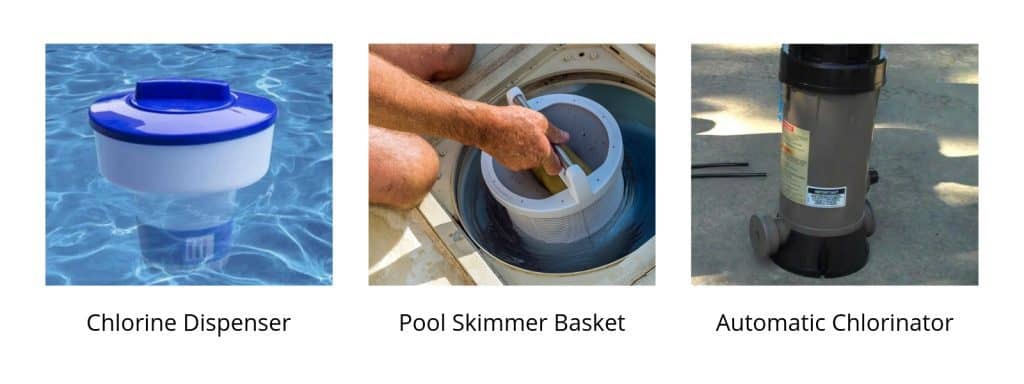Chlorine tablets offer a cheap and convenient way to sanitize a pool, but how you add them to your water matters just as much as type of chlorine you use.
In this article, we’ll tackle the most common methods for adding chlorine tablets to a pool, along with the pros and cons of each.
Quick answer: Install an inline chlorine feeder if you can afford to, otherwise a floating dispenser (or multiple for larger pools) will get the job done. Never put chlorine tablets in your skimmer basket.
3 Ways to Add Chlorine Tablets

There are ultimately 3 methods for adding chlorine tablets to an inground or above-ground pool.
Let’s break them down.
1. Use a Floating Dispenser (Best on a Budget)
A floating dispenser is a small, plastic, and inexpensive container that’s filled with chlorine tablets and left to float on the surface of your water.
The floater has adjustable vents to restrict the amount of water passing through, allowing you to control how quickly your tablets dissolve and how much chlorine is released into the pool over time.
Most floaters will hold around 2 -3 lbs worth of chlorine tablets at one time, equating to roughly 3-5 large tablets (3 inches in diameter) — though some dispensers have a slightly larger capacity.
In general, given relatively normal pool and weather conditions, you can expect your chlorine tablets to last 5-7 days before refilling.
It’s not all good news, though. The problem with floaters is they often get stuck on steps, ladders, and other fixtures, causing a high concentration of chlorine to build up in one area of your pool.
This can be prevented using a line of string or rope attached to the dispenser while anchoring to a fixed point (away from problematic fixtures), but this may also limit the distribution of chlorine, especially for larger pools.
PROS
- Reasonable control over tablet dissolution
- No installation required
- Inexpensive (under $20 per floater)
CONS
- Can get stuck on steps and fixtures
- May require extra setup (lines to control movement)
- May require multiple floaters for large pools
2. Use a Chlorine Feeder (Best Overall)
A chlorine feeder, often called an automatic chlorinator, is a cylindrical chamber that connects to your pool’s plumbing lines.
Chlorine tablets are placed into the chamber. Then, as your pump circulates water throughout your pool, it passes through the feeder, dissolving and carrying some of the chlorine along with it.
This system uses a control valve to limit how much water makes contact with your chlorine tablets, which gives you very precise control over how much—or how little—chlorine is introduced to the pool over time.
A feeder will typically hold around 9 lbs worth of chlorine tablets, equating to roughly 18 large tablets (3 inches). For very large pools, you can find high-capacity feeders that hold up to 40 lbs.
Again, assuming relatively normal conditions, most chlorine feeders only need topping up every 7-10 days, and will sometimes last up to 2 weeks.
The only real downside to using an automatic chlorinator is the cost of installation, which can run around $100 to $150 on average.
Note: There are two categories of chlorine feeders; inline and offline. Inline feeders are often installed during a pool build, while offline feeders are added on later. Both work very well so don’t get hung up on this detail.
PROS
- Precise control over chlorine dosage
- Has a high tablet capacity for infrequent top-ups
- Better distribution of chlorine throughout your pool
CONS
- Installation may require a professional
- Relatively expensive ($100 or more)
3. Use Your Skimmer Basket (Not Recommended)
A skimmer sucks in and filters out large debris on the surface of your water, while also helping to circulate water through your pool filter.
However, some pool owners leverage their skimmer basket to store tablets, as water flows through the skimmer and passes over the chlorine tablets, causing them to slowly dissolve and release chlorine.
While this is similar to using a chlorine feeder, your tablets are always exposed to water and forever breaking down. The only way to control the flow of chlorine is to adjust the number of tablets in the skimmer basket.
As a result of this constant exposure, tablets dissolve faster than with other delivery methods and require topping-up as often as every 3-5 days.
What’s more, whenever your pump is off, the tablets will continue to dissolve inside the skimmer. This can lead to high concentrations of chlorine which becomes corrosive and potentially damaging to your pool.
PROS
- Very convenient
- Won’t cost you a penny
CONS
- No control over tablet dissolution
- Chlorine can build up and become corrosive
- Repairing corroded parts can be expensive
Which Method Should You Use?
A chlorine feeder is objectively the best option in terms of chlorine distribution, dosage control, and overall capacity.
Whether you have a small or large pool, inground or above-ground, you really can’t go wrong using an inline or offline feeder for your tablets — assuming you can justify the upfront cost to have it installed.
If cost is a factor, though, a simple chlorine floater is the next best thing. While it may occasionally get stuck on steps or fixtures, this can be mitigated using a line of string or rope.
As for using your skimmer basket to dissolve tablets, unless it’s a very short-term solution, it’s simply not worth the risk given the potential damage caused by high concentrations of chlorine.
